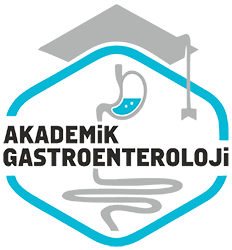karaciğer hastalıklarinda (siroz veya hepatit) homosistein ve selenyum düzeyleri
Homocysteine and selenium levels in hepatic diseases (cirrhosis or hepatitis)
- Ana Sayfa
- Sayılar
- karaciğer hastalıklarinda (siroz veya hepatit) homosistein ve selenyum düzeyleri...
Özet
Giriş ve amaç: Homosisteinin sentezinde ve metabolizmasinda karaciger önemli bir rol oynar. Karaciger hasari olustugunda homosisteinin metabolizmasinda önemli degisıklıkler meydana gelmektedir. Selenyum düzeyinin karaciger hasarinda düstügü rapor edilmektedir. Yine selenyum eksikliğinde karacigerde önemli degisıklıklerin olduğu ifade edilmekte ve patogenezdeki rolü arastirilmaktadır. Çalışmamızda karaciger hasarinda homosistein ve selenyum düzeylerinde meydana gelen degisıklıkleri ve bu degisıklıklere etki edebilecek faktörleri incelemeyi amaçladi k. Gereç ve yöntem: çalışmaya 22 kronik hepatitli (E: 12, K: 10; yaş ortalamaları: 43,90±15,02), 28 sirozlu (E: 25, K: 3; yaş ortalamaları: 42,50±16,00) hasta ile, 20 sağlıklı kontrol grubu (E: 12, K: 8; yaş ortalamaları: 36.65±8.29) dahil edildi. Etyolojik dagilim: 36’si Hepatit B virusu, 7’si Hepatit C virusu, 3’ü Hepatit B virusu + Hepatit D virusu, 1’i Wilson hastasıydi. Üç olgu kriptojenik sirozluydu. High Performance Liquide Chromotography (HPLC) cihazinda floresan dedektörle homosistein; atomik absorbsyon cihazinda grafit modunda selenyum; Abotte Aeroset otoanalizor cihazinda fotometrik yöntemle ALT, AST, GGT, albumin düzeyleri; Roche E170 modüler analitik sistem ile, kemiluminesans metodu kullanilarak B12 ve folat düzeyleri çalisildi. Metilen tetrahidrofolat redüktaz (MTHFR) geni ise, hastalardan alinan tam kan örneklerinden elde edilen DNA’lar kullanilarak incelendi. Bulgular: Her 3 grubun yaşlari arasında fark saptanmadi. Hem kronik hepatit hem de siroz grubundaki homosistein düzeylerinin kontrol grubundan istatistiksel olarak daha yüksek olduğu saptandi (p=0.001). Kronik hepatit grubu ile siroz grubunun homosistein düzeyleri arasında fark saptanmadi. Öte yandan, kronik hepatit ile kontrol grubu arasında vitamin B12 düzeyi açısından fark yoktu. Siroz grubunda vitamin B12 düzeyinin kontrol grubundan istatistiksel olarak daha yüksek olduğu izlendi. Folat düzeyi bakimindan gruplar arasında fark saptanmadi. MTHFR gen mutasyonu bakimindan da hasta ve kontrol gruplari arasında fark saptanmadi. Her iki hastalık grubundaki selenyum düzeyinin kontrol grubundan daha düşük olduğu görüldü (p=0.001). Sonuç: sonuçlarımiz göstermektedir ki sirozlu ve kronik hepatitli hastalarda gözlenen hiperhomosisteinemi folat, vitamin B12 eksikliği ve MTHFR gen mutasyonu ile ilgili degildir. Homosistein metabolizmasinda görev alan diğer enzimlerin rollerinin olabilecegi anlasi lmaktadır. Kronik hepatit ve sirozlularda belirgin selenyum eksikliğinin varligi dikkat çekicidir
Abstract
Background/aim: The liver has a crucial role in homocysteine synthesis and metabolism. Important changes in homocysteine metabolism occur when hepatic deficiency exists. Selenium levels have also been reported as being decreased in liver damage. Furthermore, many changes take place in the liver when selenium deficiency occurs, and the role in pathogenesis is being investigated. We aimed to search the changes in homocysteine and selenium levels in liver damage and determine the probable influencing factors. Materials and methods: Twenty-two chronic hepatitis (m:11, f:11, average age: 43.90±15.02), 28 cirrhotic patients (m:25, f:3, average age: 42.50±16.00) and 20 healthy subjects (m:12, f:8, average age: 36.65±8.29) were included in the study. Etiology was hepatitis B in 36, hepatitis C in 7, hepatitis B + D in 3 and Wilson disease in 1 patient. Three patients had cryptogenic cirrhosis. Homocysteine level was measured by fluorescent detector using high performance liquid chromatography (HPLC); selenium level in graphite mode by atomic absorption; AST, ALT, GGT and albumin by Abotte Aeroset autoanalyzer with photometric method; and vitamin B12 and folate levels by ELECYSIS E170 using chemiluminescence method; methylene tetrahydrofolate reductase (MTHFR) gene analysis in DNA of whole blood samples was done. Results: There was no significant difference between the three groups with respect to age. Both chronic hepatitis and cirrhotic groups had higher homocysteine levels than those of the control group (p=0.001). There was no difference in homocysteine levels between chronic hepatitis and cirrhotic groups. On the other hand, there was no difference between chronic hepatitis and control groups with respect to vitamin B12 levels. Vitamin B12 level was higher in the cirrhotic group than in controls and the difference was statistically significant. There was no difference between any of the groups in respect to folate levels. MTHFR gene mutation was similar in both patient and control groups. Selenium level was found to be lower in both patient groups than in the control group (p=0.001). Conclusion: Our results showed that hyperhomocysteinemia in chronic hepatitis and cirrhosis is not related to deficiency in folate and vitamin B12 and MTHFR gene mutation. It is seen that other enzymes involved in homocysteine metabolism might play a part in this process. It is noteworthy that selenium deficiency exists in both chronic hepatitis and liver cirrhosis.



